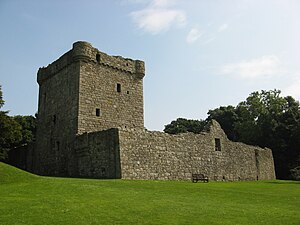Loch Leven Castle
| Loch Leven Castle | |
|---|---|
| Castle Island, Loch Leven, near Kinross, Scotland UK grid reference NO137017 |
|

Keep and west wall of the castle
|
|
| Coordinates | 56°12′N 3°23′W / 56.20°N 3.39°W |
| Type | Tower house and courtyard |
| Site information | |
| Owner | Historic Scotland |
| Controlled by | Douglas of Lochleven |
| Open to the public |
Yes |
| Condition | Ruined |
| Site history | |
| Built | 1300 CE |
| In use | Until 17th century |
| Materials | Stone |
Loch Leven Castle is a ruined castle on an island in Loch Leven, in the Perth and Kinross local authority area of Scotland. Possibly built around 1300, the castle was the location of military action during the Wars of Scottish Independence (1296–1357). In the latter part of the 14th century, the castle was granted by his uncle to William Douglas, 1st Earl of Douglas, and remained in Douglas' hands for the next 300 years. Mary, Queen of Scots was imprisoned here in 1567–1568, and forced to abdicate as queen, before escaping with the help of her gaoler's family. In 1588, the Queen's gaoler inherited the title Earl of Morton, and moved away from the castle. It was bought, in 1675, by Sir William Bruce, who used the castle as a focal point in his garden; it was never again used as a residence.
Today, the remains of the castle are protected as a category A listed building, in the care of Historic Scotland. Loch Leven Castle is accessible in summer by the public via a ferry.
A castle may have been constructed on Castle Island by 1257, when the 16-year-old King Alexander III of Scotland was forcibly brought there by his regents. During the First War of Scottish Independence (1296–1328), the invading English army held the castle, then named Loch Leven Castle, which lies at a strategically important position between the towns of Edinburgh, Stirling and Perth. Parts of the present fortification, the curtain wall, may date from this time and were perhaps built by the occupying English. The castle was captured by the Scots before the end of the 13th century, possibly by the forces of William Wallace.
...
Wikipedia

